Saddle fit - Western compared to English Part 3
We are no longer building saddle trees, but we have two videos about how Western saddles fit horses available on our westernsaddlefit.com website.
I'm finishing up here on the short series comparing saddle fit between English and Western saddles. After looking at the history and basic design of both types of trees, I moved on to the first few of the commonly taught saddle fit "rules". There was some common ground with most of those ones. Today I'm writing about the last of the commonly taught "rules", some of which just don't apply to Western saddles, and maybe not even to English ones. (Warning - saddle fit “rule” heresy coming up...)
#6 Stability on the horse
This one we can all agree on. If the shape of the tree (tree and panels on English saddles) match the shape of the horse then, just like two teaspoons nestled together, the saddle sits solidly and doesn't shift out of place during normal use. In fact, it is hard to shift it out of place, and it will go back there quite quickly as the horse moves unless you specifically hold it in the wrong place with something like a breast collar. The saddle will not want to roll around on the horse if you lean sideways to open a gate. It won't want to shift towards you a lot when you mount. You won't constantly be shifting it back to center as you ride. If you notice these things happening, there may be other reasons for it occurring, but often it is that saddle just doesn't fit very well – the shapes don’t match.
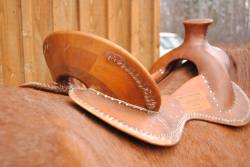 |
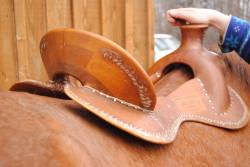 |
The same goes for back to front. If you alternately push down on cantle and fork, the tree should not noticeably "rock" back and forth, lifting at the front and then at the back. (This goes along with #3 from the last post, even bar/panel contact.) If it does, you either have too much rock in your bars for this particular horse (as pictured above) or the tree is too wide so it "falls down" in front, lifting the back of the saddle off the horse. Either way, if you are getting significant movement when you do this test, the saddle will not work really well on that horse.
Now, onto the ones that drive me crazy...
#7 The saddle must be "balanced" front to back
I see this one explained in many ways as I read the abounding lists of "rules of saddle fit" on the internet. Some say that the pommel and the cantle must be level with each other. Others say that certain styles of saddles (for example, dressage saddles) should have the cantle X amount (pick your number) higher than the pommel. And if the pommel and cantle aren't in this relationship to each other, then the tree is obviously too wide or too narrow for the horse, with the most common example being given is that the pommel is too high and therefore the tree is too narrow.
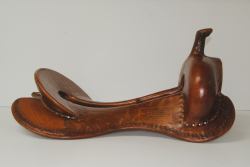 |
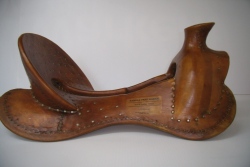 |
Let's look at how this doesn't apply to Western saddles. First of all, cantles have been, in the past, as low as 1 1/2" (the lowest we have made is 3", as pictured on the left) and up to 6" in some of those old time high back saddles. (The one in the picture on the right is 6" tall.) Forks also range from really, really low on calf ropers to really, really high on some old, narrow saddles with high gullets. And then let’s add the horn. How high is that supposed to be so the saddle is "level and balanced"? Look at the pictures above. How does the relative height of fork and cantle tell you anything about how these trees “fit” the table? They tell you just as much if you put the saddle on the horse!
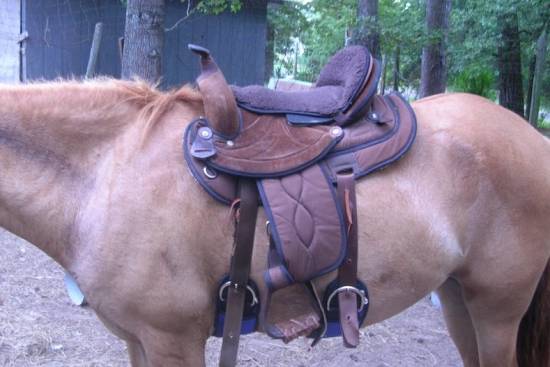
Obviously, comparing fork and cantle height relative to each other is a ridiculous way to tell how the saddle is fitting the horse. However, the idea behind this does have some merit. I keep talking about how if a tree is too wide, it will "fall down" in the front, tipping forward till something contacts the horse - whether that be the top half of the bar pad, just the top corner of the bar tip, or the underside of the gullet resting on the horse's withers. If this happens, the back of the saddle is usually lifted off the horse too, as seen in the picture above. (But hey, the seat is "level" - see below - so it must fit!!) So the idea really isn't about the cantle and fork at all. It is about where the bars sit on the horse's back relative to where they were made to sit. If the bar spread or bar angle is too wide, the bars are tipped too far down at the front compared to where they should be. It is almost like you need X-ray eyes to see the tree inside the saddle. But once you understand what is happening there, you can see the effects somewhat by looking at how the saddle sits on the horse.
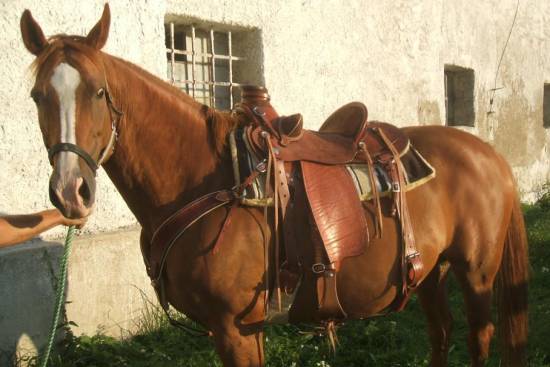
On the other hand, a tree that is too narrow should, theoretically, look like it is "tipped back" a bit. However, while I have seen many pictures of English saddles where you can see this happening, you just don't see it the same way with Western saddles. So often saddles are placed too far forward, as pictured above, up on the shoulder blades where the horse is much wider than the tree made for. Yet the saddle still doesn't look like it is tipped back. So looking at how a Western saddle sits on the horse is not a good way to tell if it is too narrow. (If you are unsure on where a Western saddle should sit on a horse, please see our Proper Position of a Western Saddle page.)
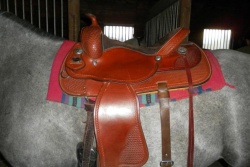 |
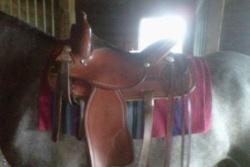 |
By the way, please DO NOT look at the levelness of the skirts to try to tell how "balanced" the saddle is on the horse (as is taught by the most popular book on saddle fit). I had someone write and say that a saddle fitter had told them that they needed to move the saddle inches forward, so it actually sat on the horse's shoulder blades, to make the skirts level, in order to make the saddle "fit properly". You can see in the pictures that the skirts are now level, but this is one of the few times I have seen a Western saddle look like it is “tipping back”. The person who gave that advice obviously knew nothing about how western saddles are made. Skirts are added later, and the way they are shaped by the saddle maker as he cuts out the leather determines if they run uphill, downhill or are level. Also, a common saddle maker's drawdown stand design does not set the tree at the same slope as a horse's back, so if the maker builds skirts that are level on that particular stand, they run will downhill toward the front on a real horse.
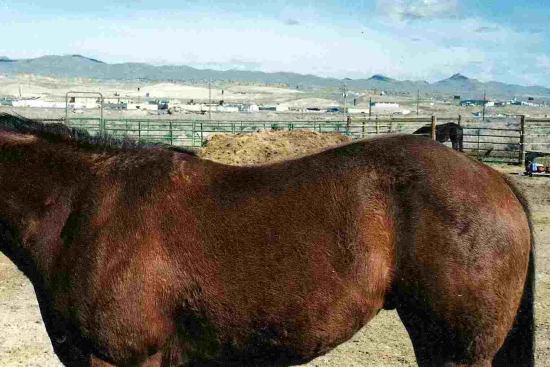
Besides this, some horses are built very downhill. (In this picture, the horizontal pipe in the background is a good marker to see how angled the back is under where the bars go. That is the important area rather than the top line.) On these horses, the bars still need to match the shape of the back, and the saddle will end up looking like it is running downhill toward the front of the horse, because that is how the horse is sloped. Some people try to compensate in the tree to make it more level. If they try to lift the front, they will most likely have the bars too close together, minimizing the surface area on the horse and probably causing high pressure points at the bottom of the bars. On the other hand, if they try to spread the bars at the back wide enough to apart to drop them further down the side of the horse to lower the back of the saddle, they run the risk of the cantle gullet or ground seat putting pressure on the spine. (The feasibility of doing this is very questionable.)
Conclusion, the fundamental idea behind this "rule" is that by looking at the "levelness" of the saddle on the horse, you can tell if the bar spread is too wide or too narrow for the horse. But unless you really do have X-ray eyes, you can't see the bars on the horse's back, and that is what is important. There are far better ways to know if a tree is too wide or too narrow than by standing back, looking, and guessing at things that you can't really see. So this "rule" should be chucked when evaluating Western saddles, even though there is some reasoning behind it that you can apply, albeit very carefully…
#8 The seat must be "level"
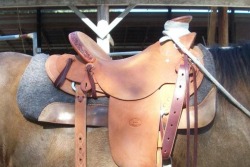 |
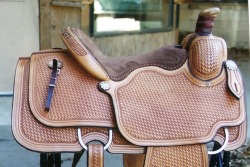 |
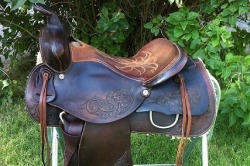 |
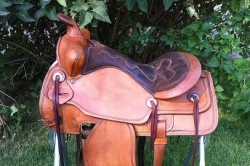 |
This one bugs me even more. Above are four pictures of different types of seats in saddles ranging from good to horrendous. But where, on any of them, do you see a "level" spot? In fact, when you look at English saddles, where is the seat actually "level"? This terminology often goes along with #7, and is sometimes called a "balanced seat". I have seen it stated that "the deepest part of the seat should be the lowest point". Umm - the deepest part of a hole IS the lowest point... Yes, there is always a spot that is lowest, and that is where the rider's pin bones (seat bones in English terminology) will end up because gravity always works, but that spot is very rarely “level".
OK. Terminology aside, where does this idea come from? With English saddles, the shape of the seat that you see is very closely related to the shape of the tree, as I described in part one. So if the tree is tilted backwards or forwards because the arch is too narrow or too wide for the horse, you do see an obvious change in which part of the seat is actually the lowest when the saddle is on the horse. This makes a difference as to where the rider ends up relative to where the seat was designed for them to be and where they are situated relative to the stirrup bars. So what this "level seat" idea is trying to say, in a very confusing way in my opinion, is that the seat must be situated so the rider can be in balance. And with the way English saddles are designed, the width of the arch relative to the horse does affect this.
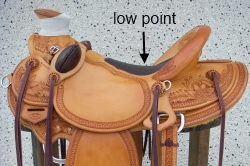 |
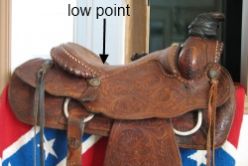 |
However with Western saddles, the low point of the seat is determined, not by the tree, but by how the saddle maker puts in his ground seat on top of the bars of the tree, as I also explained in part one. You can tell nothing about how the bars of the tree sit on the horse by how the ground seat is shaped. Yes, the shape of the seat affects how and where the rider will end up on the horse. For example, in the picture above on the right, the rider's weight will be primarily carried toward the back of the bars (bad) whereas on the saddle on the left it will be quite central (good). And this does affect the pressures under the saddle for sure. But it doesn't affect how the tree actually fits the horse! They are totally independent things.
#9 The saddle cannot extend past the T18, the 18th thoracic vertebra, the last rib, etc.
The idea behind this "rule" is that the loin of the horse is said to be the weakest part of the back and therefore cannot carry any weight or else it will be damaged. I have seen it called the "non-weight bearing" part of the back. I have written about this in the past, so rather than going over it all again, I am giving you links to more information than I could write here. But the more we are contacted by people who are more familiar with English saddles than Western ones, the more often this topic comes up. Since English saddles extend a minimal distance behind the rider, if there was weight carried on the loin, the saddle would be extremely long or placed very far back on the horse. However...
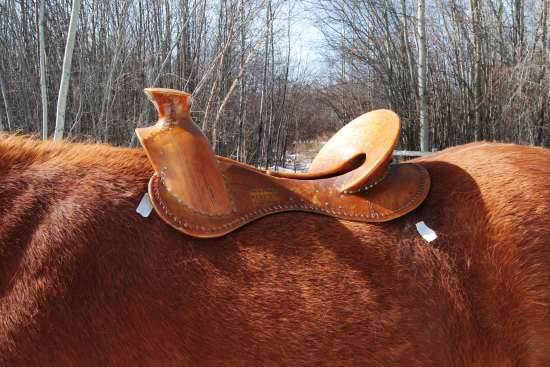
For anyone who has used Western saddles extensively in their life, this just makes no sense. Firstly, almost every western saddle out there extends onto the loin of the horse. Western style saddles have been used for centuries. They are still used daily for long hours, over rugged terrain, doing all sorts of jobs on working ranches. Yet the design still persists. If weight on the loin cripples horses, then this design would have been junked a lot time ago.
Secondly, there is no way to tell which part of the back is weaker or stronger, and there is no research which has shown that the loin cannot carry weight. The loin has a structure which is different than the rib cage but it is still strong. To repeat a quote from Dr. Kevin Haussler, an equine researcher at Colorado State whose area of expertise is the equine back, "If horses were really this “weak” at the thoracolumbar junction then no one would be able to ever ride a horse." (In fact, the whole "kissing spine" problem, which can debilitate a horse, happens in the thoracic spine, where the weight "should" be carried according to this rule…)
Of course we completely agree that excess pressure, particularly high pressure points (Poking) is very damaging to the loin, as it is to other areas. However the idea that carrying any weight is harmful is just not true.
#10 The cinch has to be vertical, hanging in the "girth groove" of the horse
I find it very interesting that this "rule" isn't on saddle makers' sites, but is in a best selling book from an author who has had a lot of influence on the veterinary literature, despite the fact that no studies have ever published done on rigging position and pressure measurements under the saddle. For example, it isn't (or wasn't at the time this post was originally written) taught by the Society of Master Saddlers, which is an association in England which accredits English saddle makers, saddle flockers and saddle fitters. In fact, on their main saddle fitting page, the picture of the horse and saddle clearly shows an angled girth. (They have since changed their website and the picture is no longer there, but it was! I have proof if anyone wants it...) This "rule" is also not listed the US Master Saddler's Association website. (This is more of a proprietary organization and not associated with the UK one.) Nor do I find this “rule” on many individual saddle maker's sites. It seems that saddle makers, who have a solid understanding of how saddles work in the real world, aren't too concerned with the angle of the cinch/girth, while an unsubstantiated opinion from someone who wrote a book has created a "rule" which actually goes counter to what we have heard has been shown (unpublished data) to actually happen.
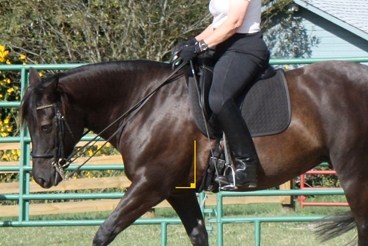
The underlying idea behind this "rule" is that it is the cinch/girth position that determines the position of the saddle on the horse, not the tree. They say that if the cinch is angled, it will pull the saddle forward till the cinch is vertical, thus moving the saddle up onto the shoulder blades where it will create high pressure points. To avoid this, they want the rigging position to be fairly far forward - full or ahead of full in a lot of cases. In English saddles, this has led to the popularity of "point billets", where one of the billets is attached directly to the end of the arch of the tree, with the idea that it will help hold the tree the "required" 2" back from the shoulder blades.

In 1868, an Austrian cavalry officer named Sir Francis Dwyer wrote a very important book entitled "On seats and saddles, bits and bitting, and the prevention and cure of restiveness in horses" which is still influencing saddlery today. On page 52, he writes, "It was a very prevalent idea some years ago, that "the point-strap" - that is to say, the girth that was placed well forward in the saddle - was the thing to depend on to prevent the saddle slipping; but experience has proved this notion to be erroneous." Another famous quote is "Those who don't know history are destined to repeat it"...
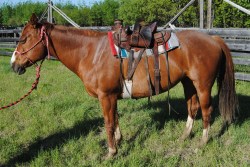 |
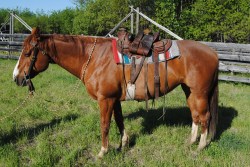 |
We've discussed this before, but it bears repeating. Yes, the cinch will go to the narrowest part of the horse, and that often means that the latigos will be angled. That isn't a problem, because it is the tree that determines the proper position of a saddle, not the rigging position. A tree that matches the shape of the horse keeps the saddle in position, and a slight angle on the latigo and cinch will not pull it out of place. (We're back to the spoons idea here.) In fact, in the pictures above, the cinch moved back a bit during riding, but the saddle stayed in place, despite the obviously angled cinch. However, when you put the rigging forward, it pulls the front of the bars down tighter, making it far more likely to impede the shoulder blades from slipping under the front bar tip, so you can actually cause saddle fit problems by doing this. I expect that pulling the arches of an English saddle down even tighter to the horse with a point billet can have severe repercussions for the horse unless the angle is totally correct.
So we feel that this "rule" needs to be totally tossed, for both English and Western.
Ultimately, it is the horse who will tell you about how the saddle is working. If you know the horse you are riding well, or if you have ridden enough horses over enough time to know what "normal" feels like in their motion, you will be able to notice differences in their movement if they are restricted by their saddle or if it is causing them pain. Misbehaviour can result from many things, but a saddle that hurts them should always be considered.
Knowing whether a saddle fits properly isn't achieved by blindly obeying a set of "rules" without understanding why they were made in the first place. By understanding and following basic Principles, you will have a saddle that fits your horse. What are those Principles? The three Ps:
1.) Allow the saddle to be in the proper Position on the horse.
2.) No Poking - no high pressure areas.
3.) Distribute the Pressure over as much surface area as possible without breaking Principle #2.
It really ain't rocket science...
